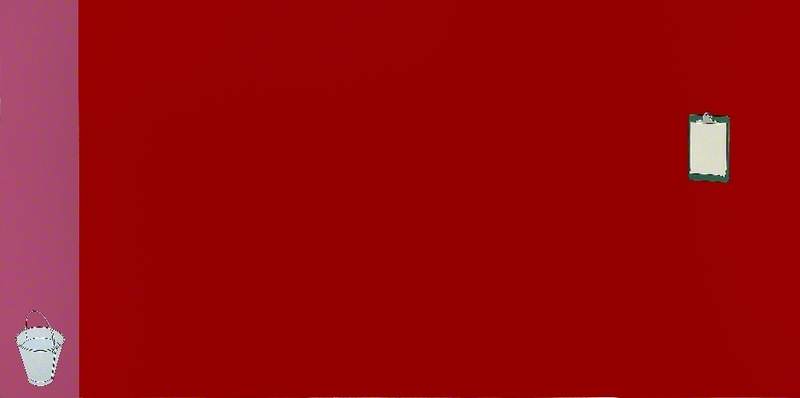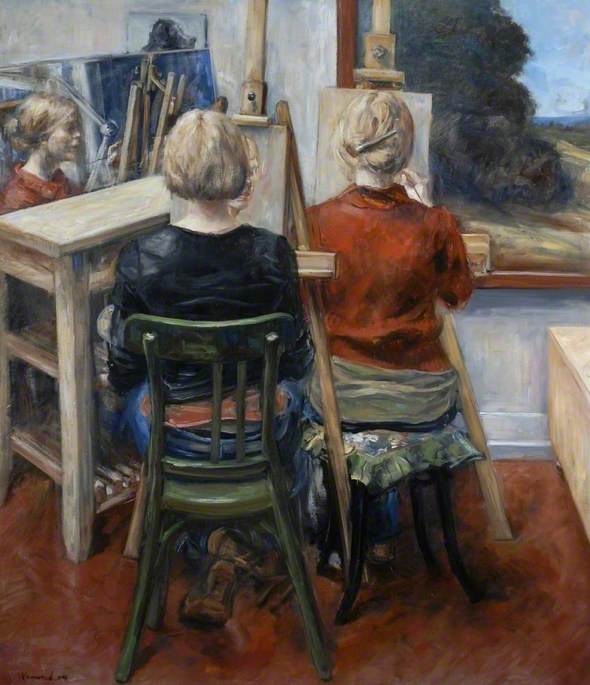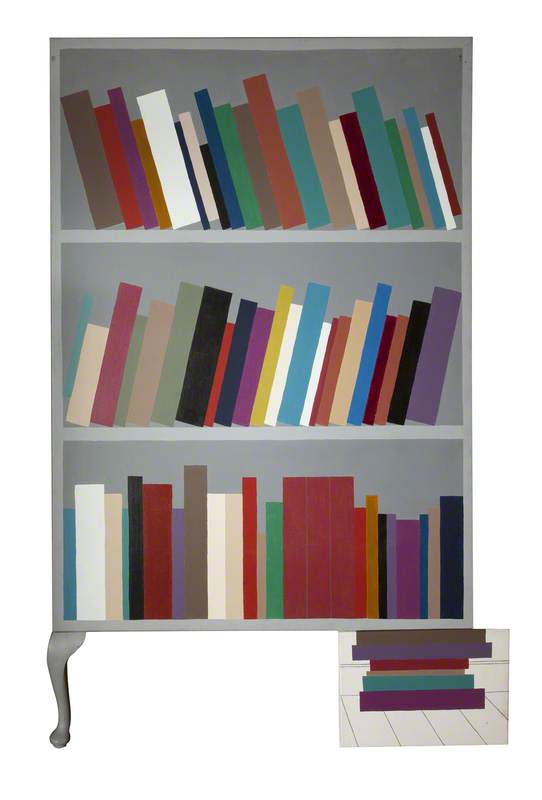The Funnest Part of Art History for Me to Study Was
In 2016, the examination board AQA announced that the Art History A-level was to be dropped from 2018. In light of this sad news, 5 friends told us why they believed the decision was such a huge loss for young people.
Cancelling Art History A-level is a distressing and retrograde step
I made my all-time academic choice more than 30 years ago, when I opted to study Art History for A-levels. At the fourth dimension, several people tried to discourage me, telling me to cull a proper subject instead. I'm not a specialist and I've never worked for a gallery, but the cultural literacy that I gained sitting at the feet of my instructor Paul Kilsby and Charlie Mussett gave me a foundation on which to build a lifetime of looking at visual arts. I wish every teenager could have the same experience.

Art, particularly gimmicky art, often feels intimidating. An art gallery can exist like a maze without an obvious entrance. I do not think nosotros should assume that huge company numbers at galleries like Tate Modern hateful a corresponding bask for the avant-garde. Although more than than five million people accept visited the Baltic Gallery in Gateshead since it opened ten years ago, it has always been my hunch that many of them go up to the pinnacle floor in the lift, expect at the wonderful view of Tyneside, descend, and walk straight out again. I hope I'm mistaken.
I'chiliad not blaming the visitors. Oftentimes galleries don't take good interpretation to aid viewers sympathise what a particular artist is trying to do. I know it's a difficult residual. Y'all don't want too much interpretation, because information technology risks overwhelming your response. But you lot need something. I call up visiting a testify past the Dutch artist Marker Manders. I couldn't find a manner in. And then the invigilator saw me puzzling and mentioned the artist's obsessive compulsion about the number five, and I suddenly got and then much more from the installations. But this is one of only a couple of times in my experience that I've had help from gallery staff.
Mostly, it feels equally if you should lower your phonation, rather than discuss the work. Sometimes, curators seem to be creating exhibitions to print other curators, rather than to inspire their visitors. I suspect that many people living in the shadow of i of these bang-up Lottery-funded ziggurats of high fine art never dream of going inside, despite the fact that it has been almost entirely funded with their own money. They've got ameliorate things to do, or they feel it isn't for them. If I'm correct, this must be partly about the atmosphere of many galleries, and partly about the epitome of contemporary art and partly nigh the lack of expert art instruction. Pedagogy in fine art and music is about sharing cultural capital, and enabling people to enjoy their birthright. So cancelling Art History A level is a sad and retrograde pace.
What does a citizen of Uk need to know? The government is rightly keen for us to exist literate and numerate and to know something virtually science. I besides retrieve that young people should know nearly sex. And I call back they should know near art. These are the languages in which a skilful life is lived. Everything else tin be learned subsequently.
Tom Shakespeare, Professor of Disability Research, UEA
My Fine art History isn't 'Soft'! On the alternative of difficult, meaningful subjects in secondary pedagogy
In the late 1990s, in central Georgia, I sat the US equivalent of the Art History A-level: Advanced Placement Fine art History. It was incredibly difficult. We alternated between rote memorisation of ancient Greek pottery forms, and the sorts of analytical discussions of 'meaning' that students in their late teens are rarely pushed to appoint with in a structured, bookish way. I don't remember how well I did on the examination and, really, it doesn't affair. That Art History class inspired my ambition and gave me management. It didn't change my life, it gave all the things that I was interested in context and significant. I entered University filled with confidence about what I wanted to exercise with my life and Art History has always been part of it.

So much of the discussion of the emptying of the Art History A-levels has focused on how enriching the bailiwick is for learners who eventually work in unrelated fields. That is absolutely the case. Those belittling discussions of intangibles make students amend writers and communicators. If art is a proxy for culture, the exposure to and exploration of art from around the world opens students up to alternative ways of thinking and is a reasonable avenue for challenging xenophobia and racism. Groovy stuff... but what about those of us who, quite literally, use the contents of their secondary school Art History pedagogy every mean solar day? That's me. As I saturday in 2007 on a beautiful Greek island, logging beautiful archaeological finds from the week'south excavations, I cannot even brainstorm to describe how thankful I was that I had memorised those pottery forms when I was 16 years one-time. Every fourth dimension I wrote down 'kylix handle fragment', I felt amazing.
I found a career in Art History and I don't think anyone would call my work soft. I study antiquities annexation and smuggling and, these days, fine art criminal offense, thanks to my Advanced Placement Art History form which was followed by a PhD in Archeology from Cambridge and a research fellowship and now a Lectureship at the Academy of Glasgow. Considering of Art History, I've hacked my style through Central American jungles with a machete to inspect looted Maya sites, picked my way through earthquake damaged temples in South asia, and driven over dry riverbeds in the dead of night in the rural Andes because the roads were covered in fiery blockades. Art History has brought me salmonella, ringworm and athlete'due south human foot, severe sunburn, a torn eardrum, and a 'high altitude affair' (to quote my doctor in La Paz) that was never fully diagnosed but produced constant fever and kept my at-rest centre rate at 130 bpm. Fine art history has caused me to alive in a tent for six-month stretches and stay in the kinds of 'hotels' where turkeys (two of them!) fall into your bed through an open window at dawn. Fine art History has me engaging with policymakers in the UK government, in other governments, and at an international level at the United nations, UNODC, and UNESCO. My specific piece of work in Art History, I'm told once more by the United kingdom of great britain and northern ireland Government and others, is part of our international fight against global terrorism.
Soft?
Where does that leave students like me who see the Art History A-level every bit their pathway into a rewarding career? With this latest cull, we really are not offering them anything. Yes, it is hard to design tests for Art History and hard to appraise those tests. By 'soft', critics don't hateful 'also piece of cake', they mean 'too fluffy'. Aside from regurgitating Greek pottery form names, which I promise you lot IS useful, writing about art is challenging, fifty-fifty for those of us who do that for a living. But so what? Isn't that exactly why nosotros should exist supporting students who choose this 'soft' only difficult topics of study? To paraphrase Kennedy here, shouldn't we encourage subjects similar Art History not because they are like shooting fish in a barrel but because they are hard?
Dr Donna Yates, Lecturer in Antiquities Trafficking and Fine art Crime, University of Glasgow
Pallant House Gallery introduces free entry for students to increase access to art
It saddens me to hear of the plans to axe the teaching of A-level Art History. To me, it is non so much a 'soft' subject, opposite to what Michael Gove might believe, equally a tool for understanding the visual civilization in which nosotros live and the history of our societies. My schoolhouse did not offer Fine art History as an option, and so, inspired by a trip effectually Italian republic, I enrolled onto an evening class at an adult education centre and set up about undertaking an A-level in a twelvemonth. It was a tough call – the course tutor didn't have fourth dimension to teach united states of america our 'special field of study' in just two hours a week and so, somewhat ambitiously, I taught myself about the High Renaissance and Mannerism in my school library. Predictably, my school teachers were not at all happy, assertive that it distracted me from my 'existent' subjects: Geography, History and English Literature. Simply as a sixteen-yr-old, those discussions near the history of art with a group of adults of all ages changed the course of my life, leading me to study it at the University of Warwick and subsequently the Courtauld Institute, and ultimately to pursue it equally a career as a museum curator.

I didn't go into information technology for the promise of a well-paid career: I knew I wanted to work in public museums, and have only worked in the charity sector during my career. Nonetheless, in an era of substantial tuition fees it seems that students from less privileged backgrounds will understandably be pushed to study 'hard' subjects at academy with clear career paths to well-paid and established professions, which may be worthy and valuable, but I believe a rounded gild also needs artists, academics, writers, museums curators and what we might call 'servants of culture'. I suspect that if it hadn't been for my elderberry sister studying to be a doctor, my parents might have pushed me towards law or some other equivalent area. I was fortunate to have parents that supported my wish to study Art History as they recognised my passion and knew that I would piece of work hard.
Ending the A-level in Art History removes yet some other entry indicate for students from different cultural and less affluent economical backgrounds to study information technology in higher education, and information technology will inevitably become an increasingly elite bailiwick, as it was in the past. Of form, nigh Fine art History departments accept students without a previous A-level in the subject, but the reality for me is that if I didn't have that pre-understanding of the subject, I might non have made that leap to a completely unknown discipline and I would accept probably studied something else instead and my life would probably take been quite different.
Furthermore, I worry that as the details of Brexit are negotiated the doubt for international students and instability of the pound will inevitably affect both the finances and teaching mix of our university courses, particularly those with international programmes that do good from schemes such as Erasmus, equally I did when I studied Renaissance fine art for a term in Venice every bit office of my degree at the Academy of Warwick.
The axing of the Art History A-level signals a marginalisation of the subject, and in such times information technology is increasingly important for museums and galleries to discover ways around curriculum relevance and enabling access. Although as an independent charitable museum Pallant House Gallery is dependent on ticketed entry, this fall we have introduced free entry for all students as a style to enable art to exist an important part of students' life whatever they study. It's a modest thing, but in such times, museums need to do what we can to increase access for students.
Simon Martin, Artistic Manager Pallant Firm Gallery
Fine art History A-level was a lifeline for me at school
I am very sad to hear that Art History A-level is to be axed in England. It is already incommunicable to written report Art History as a stand-lone subject for Scottish Highers, I believe. I never studied Fine Art, but Fine art History A-level was a lifeline for me at school, complementing and extending the other subjects I studied (English and French). I took it against the wishes of my male parent, who idea it was a soft option and would brand me unemployable, but in fact it prepare me on a career path to university and across.

Learning
Patrick Hughes (b.1939)
Grundy Art Gallery
More than that, though, Art History A-level taught me to think, to be curious, to accept risks and to try things out. Helping me realise that circuitous ideas could be expressed visually, it opened up a whole new way of thinking about and agreement the earth and myself within it. I'k sad that immature people won't get that any more than – they will exist the poorer for it, and so will the earth.
Every bit a professional working in the world of art, I regret that ours is seen as a field that is less worthy of study than others. But more often than not I regret that young people will no longer have the pick to formulate ideas in the context of the visual, to understand fine art as a powerful context for thinking things through.
Fiona Bradley, Director, The Fruitmarket Gallery
The arts sector has been and remains one of the few genuine success stories in modern British guild
I was extremely disappointed to larn that after 2018 information technology will become impossible to written report History of Fine art at A-level. This is nevertheless another example of an increasingly instrumental view of education that narrows both the ambitions and opportunities of young people in this country.
Art history isn't a 'soft' discipline. It is ametafield of study that brings together so many other disciplines, and is integral to any serious understanding of our past. Moreover, in the final few decades, it'south been an invaluable tool to expose the social, sexual and racial prejudices that aren't always expressed in words.

The arts sector has been and remains one of the few genuine success stories in modern British society. This country's international reputation depends in part on the connected excellence of its art institutions. I worry that this unnecessary decision will cause long-term damage to the cultural life of the nation.
As a Director of Studies in History of Fine art at the University of Cambridge, I want to make it very articulate that we volition continue to welcome applications from those who haven't had the opportunity to study Art History at school. Whatsoever AQA declares, this thrilling subject should be open to all.
Dr James Play a joke on, Director of Studies in History of Art at the University of Cambridge
Update: Fine art History is saved!
On 1st December 2016, after a successful campaign led past the Association of Art Historians, information technology was announced that a new exam board, Pearson, was to develop a new A-level in the History of Art for teaching from September 2017.
When it was announced that the History of Fine art A-level was to exist discontinued, Art Uk joined the thousands of voices telling the earth #WhyArtHistoryMatters. We heard from lecturers, heads of department and directors who all told us what they'd gained from studying fine art history, and why it mattered that the opportunity to do so was being taken away from young people. At Art Britain, our ethos is that fine art should be accessible and open to the whole nation, and taking away the opportunity to report art at A-level was depriving young people of the opportunity to learn almost a function of their cultural heritage.
For some people, studying the History of Fine art volition be the gateway to a lifelong love of the field of study, and they may keep to be the future directors and curators of some of the Britain'south astonishing arts institutions. For others, it volition just exist a chance to study a subject they might never have felt able to admission otherwise, a mode into talking about new ideas and combining the study of art with literature, politics and science. As the artist Jeremy Deller says, 'Fine art history is the study of ability, politics, identity and humanity, it makes perfect sense to keep the exam.'
People all beyond the arts sector take reacted with relief and joy to hear the news – including Charles Saumarez Smith, the Chief Executive of the Royal Academy: 'On behalf of the Regal Academy of Arts and the Royal Academicians, nosotros are delighted that the fine art history A-Level exam has been saved. Art history teaches rigorous belittling skills and requires students to engage not only with fine art but with history, literature, politics, languages and the sciences. In a culture dominated past the visual, there is a powerful argument that we need such skills more than e'er.'
Art Uk was similarly delighted that the History of Fine art A-level is back on the syllabus.
Andrew Ellis, Director of Art Great britain
More stories
Artworks
Learning resources
marchantallis1956.blogspot.com
Source: https://artuk.org/discover/stories/why-art-history-matters-five-arts-professionals-have-their-say

0 Response to "The Funnest Part of Art History for Me to Study Was"
Post a Comment